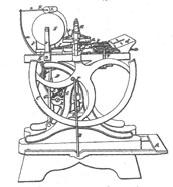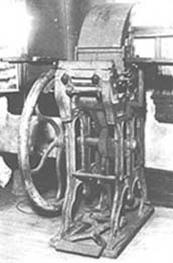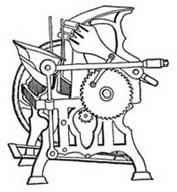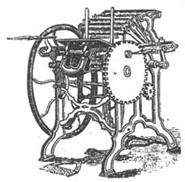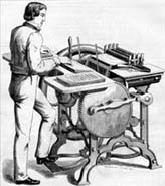|
GEORGE PHINEAS GORDON (1810-78)
Gordon, was also another regarded by many as the inventor of the jobbing platen, probably due to the popularity and longevity of his many various Franklin presses.
After leaving school he became an actor for a short time and then settled in New York where he learned the printer's trade. Sometime before 1835 he is recorded as inventing a 'speedy card press, however no records or patent exist. He returned to the printing trade for several years before embarking on another venture, building and patenting a working model in March, 1850. Ralph Green, in his book A History of the Platen Jobber (1953) states: "This press followed somewhat the same form as the Ruggles Engine Press but was smaller, and [the forme] was not upside down. Nothing radically new was embodied in its mechanism and the only claims in the patent covered a method for gripping the sheet and a horizontal traveling brayer roller which served to distribute the ink transversely across a rather large rear roller acting as a distributing table." The writer also stated no pictures of this press had ever been found. The cutaway drawing (top) was taken directly from the patent.
The introduction of Ruggles novel 1851 Card & Billhead Press inspired Gordon to dispense with the horizontal format in favour of arranging the bed in the vertical position and hinging it to the lower edge of the fixed platen, inclined about 45 degrees in front of it. This he named the 'Alligator', seemingly appropriate, as it had a rather unhealthy appetite for the hands and fingers of its feeders, due to the dangerous action! The bed, when at rest, was vertical and hinged just below the baseline of the chase. This oscillated to and fro driven by a cam and toggle device, through a 45 degree angle and the forme pressed against the rigid platen, obviously fairly quickly! [This same mechanism was used extensively by later press builders, but in the reverse order, that is, the platen was hinged and the bed was fixed]. The press, and others of the same basic design, was powered by a foot treadle and had on its main shaft a large flywheel to give the press steady momentum. The curved rectangular ink distributing plate mounted atop the chase does not indicate an efficient means of breaking down and distributing a fresh ink film uniformly, unless of course there was some sort of vibrating mechanism observers have missed - possibly the top roller. [As his earlier horizontal press had a traveling ink brayer, it seems illogical that this later one didn't!] Only a few of these presses were made, and it was asserted, correctly or incorrectly, that "Gordon soon realized the dangers in the operation of the press, and immediately bought back the few he had sold." Strangely, this press does not seem to have been covered by a patent.
After several other attempts, including his Yankee, an 'improved' Alligator (according to Comparato) and a small, fast hand-powered bench-type roll-fed platen called Firefly [patent 9234, August 1852] -- supposedly in a dream -- patriot/printer Benjamin Franklin described a 'better mechanism' to him and Gordon put it to work in 1852. This he called the Turnover, due to the novel cam-operated rocking motion of the platen, which did a partial turnover between the feeding and printing positions. [I believe only the rocking platen and oscillating type bed was 'communicated' from his hero, Ben Franklin -- as Gordon indicated in a letter to Ruggles some years later that he was indebted to him for the idea of using a vertical bed and hinged platen]. The type bed oscillated back and forth on legs, propelled by toggles. Inking was achieved with three forme rollers, supported in saddles, which rolled from the curved plate above the bed, down and up again over the type forme before and after each impression, in the same manner as his Alligator. The Turnover was regularly advertised and probably a number were sold, but within a year or two changes were made both to improve and simplify the mechanism. Eventually, by 1854, the press appeared basically in its final form and was re-named the Franklin, in honour of his hero -- to which the prefix Gordon was usually added! The bed and inking apparatus was still driven by cams and toggles like its predecessors. [Historians have often mistaken this press with his later 1856 Jobber due to the same title no doubt and the overlap in manufacture.]
The 'double' ink disk, as applied to jobbing presses, first appears in January, 1856 [patent 14016]. This was described as 'Combining with a rotating disk an annular ring or outside disc, the two revolving each in an opposite direction to the other, for the purpose of breaking up the ink, so that it shall by such contrary motions become evenly distributed and thus imparted to the inking rollers' This improved the inking considerably as the rollers passed over an entirely new surface every time they reached the disks, and was very successful. Strangely, a wooden 'single' ink disk had been used 35 years earlier by Daniel Treadwell on his bed & platen presses and appears to have been overlooked.
|
|
